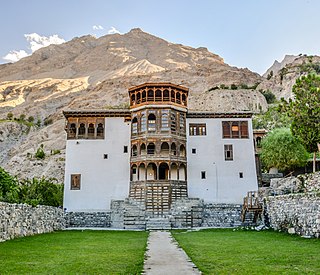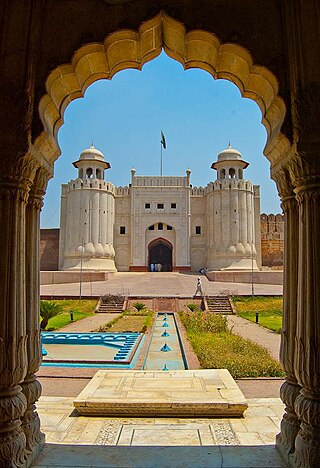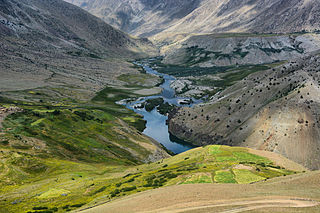
Balti is a Tibetic language natively spoken by the ethnic Balti people in the Baltistan region of Gilgit-Baltistan, Pakistan, Nubra Valley of the Leh district and in the Kargil district of Ladakh, India. The language differs from Standard Tibetan; many sounds of Old Tibetan that were lost in Standard Tibetan are retained in the Balti language. It also has a simple pitch accent system only in multi-syllabic words while Standard Tibetan has a complex and distinct pitch system that includes tone contour. Due to effects of dominant languages in Pakistani media like Urdu, Punjabi and English and religious impact of Arabic and Persian languages, Balti, like other regional languages of Pakistan, is continuously expanding its vocabulary base with loanwords.

Baltistan also known as Baltiyul or Little Tibet, is a mountainous region in the Pakistani-administered territory of Gilgit-Baltistan and constitutes a northern portion of the larger Kashmir region that has been the subject of a dispute between India and Pakistan since 1947. It is located near the Karakoram and borders Gilgit to the west, China's Xinjiang to the north, Indian-administered Ladakh to the southeast, and the Indian-administered Kashmir Valley to the southwest. The average altitude of the region is over 3,350 metres (10,990 ft). Baltistan is largely administered under the Baltistan Division.

Skardu is a city located in Pakistan-administered Gilgit-Baltistan in the disputed Kashmir region. Skardu serves as the capital of Skardu District and the Baltistan Division. It is situated at an average elevation of nearly 2,500 metres above sea level in the Skardu Valley, at the confluence of the Indus and Shigar rivers. The city is an important gateway to the eight-thousanders of the nearby Karakoram mountain range. The Indus River running through the region separates the Karakoram from the Ladakh Range.

Indo-Islamic architecture is the architecture of the Indian subcontinent produced by and for Islamic patrons and purposes. Despite an initial Arab presence in Sindh, the development of Indo-Islamic architecture began in earnest with the establishment of Delhi as the capital of the Ghurid dynasty in 1193. Succeeding the Ghurids was the Delhi Sultanate, a series of Central Asian dynasties that consolidated much of North, East, and Central India, and later by the Mughal Empire during the early 16th century. Both of these dynasties introduced Islamic architecture and art styles from West Asia into the Indian subcontinent.

Baltit Fort is a fort in the Hunza valley, near the town of Karimabad, in the Gilgit-Baltistan region of northern Pakistan. Founded in the 8th century CE, it has been on the UNESCO World Heritage Tentative list since 2004.

Altit Fort is an ancient fort in the Altit town in the Hunza valley in Gilgit Baltistan, Pakistan. It was originally home to the hereditary rulers of the Hunza state who carried the title of 'Mir', although they moved to the somewhat younger Baltit fort nearby three centuries later. Altit Fort and in particular the Shikari tower is around 1100 years old, which makes it the oldest monument in the Gilgit–Baltistan. The fort has received the UNESCO Asia Pacific Heritage Award for Cultural Heritage Conservation in 2011.

Shigar is the headquarter of its namesake district and tehsil in the Baltistan division of Gilgit-Baltistan region in northern Pakistan. It is located on the bank of the Shigar River in the most remote part of the region. It is a popular site for tourists and trekkers and contains many historical buildings of architectural significance associated with several different communities.

The Shigar Valley is a valley in Gilgit Baltistan in northern Pakistan that is watered by the Shigar River, and centred on the town of Shigar. The valley stretches about 170 km from Skardu to Askole and is the gateway to the high mountains of the Karakoram. The town of Shigar is the largest settlement in the valley. Even though the Shigar Valley is a remote and largely inaccessible place, there are several villages in the valley. Askole is the last settlement in the Shigar Valley, which is still far from the high mountains. Shigar was an administrative sub-division of Skardu District before it was made a district in its own right.

Khaplu, also spelt Khapalu, is a city that serves as the administrative capital of the Ghanche District of Pakistan-administered Gilgit-Baltistan in the disputed Kashmir region. Lying 103 km (64 mi) east of the city of Skardu, it was the second-largest kingdom in old Baltistan under the Yabgo dynasty. It guarded the trade route to Ladakh along the Shyok River east of its confluence with the Indus.

The Historic Cities Programme (HCP) of the Aga Khan Trust for Culture (AKTC) promotes the conservation and re-use of buildings and public spaces in historic cities of the Muslim world. HCP undertakes the restoration and rehabilitation of historic structures and public spaces in ways that can spur social, economic and cultural development. Individual projects go beyond technical restoration to address the questions of the social and environmental context, adaptive reuse, institutional sustainability and training. In several countries, local Aga Khan Cultural Service companies have been formed to implement projects under the supervision of the HCSP headquarters in Geneva.

Tourism in Pakistan is a growing industry. In 2010, Lonely Planet termed Pakistan "tourism's 'next big thing'". The country is geographically and ethnically diverse, and has a number of historical and cultural heritage sites. Condé Nast Traveller ranked Pakistan The Best Holiday Destination for 2020 and also declared it the third-highest potential adventure destination in the world for 2020. As security in the country improves, tourism increases; in two years, it has increased by more than 300%.

Ganish is a village in the Hunza District within the Gilgit Baltistan region of Pakistan. It is the oldest and first settlement on the ancient Silk Road in the Hunza Valley, and is the site of various ancient watchtowers, traditional mosques, religious centers, and a reservoir. It is located 90 km away from Gilgit. The word "Ganish" is unknown but according to the local scholars, it is derived from the Burushaski word "Genish" which means gold. Ganish has been a major town for travelers since the days of the Silk Road - now the Karakorum Highway.

Gilgit-Baltistan, formerly known as the Northern Areas, is a region administered by Pakistan as an administrative territory and consists of the northern portion of the larger Kashmir region, which has been the subject of a dispute between India and Pakistan since 1947 and between India and China since 1959. It borders Azad Kashmir to the south, the province of Khyber Pakhtunkhwa to the west, the Wakhan Corridor of Afghanistan to the north, the Xinjiang region of China to the east and northeast, and the Indian-administered union territories of Jammu and Kashmir and Ladakh to the southeast.

Ali Sher Khan Anchan was a famous Balti king. He was a Maqpon dynasty king who unified Baltistan and expanded its frontiers to Ladakh and western Tibet in the east, and in the west to the borders of Ghizar and Chitral.

The Chaqchan Mosque is a mosque in the city of Khaplu, in the Gilgit-Baltistan region of northern Pakistan. Dating from 1370, the mosque is one of the oldest in the region, and dates from the time when the area's populace converted en masse from Buddhism to Islam. The mosque shares similar architecture as those built in the Kashmir Valley. It is a perfect blend of Tibetan, Mughal and Persian style of architecture.

The Shigar Fort means The Fort on Rock is an old fort of Baltistan and Pakistan located in the town of Shigar. It was built in the 17th century by the Raja of Amacha Dynasty of Shigar.

Khaplu Palace, locally known as Yabgo Khar, is an old fort and palace located in Khaplu, a city in Gilgit-Baltistan, Pakistan. The palace, considered an architectural heritage site and a significant tourist attraction, was built in the mid-19th century to replace an earlier-dated fort located nearby. It served as a royal residence for the Raja of Khaplu.
Haldi also Halde or Huldi is a village in Ghanche District of Gilgit-Baltistan, Pakistan. Haldi is a historic village of Baltistan, located at the meeting place of Saltoro river and Hushe River 28 km from district centre Khaplu.

Gultari Valley, located west of Kargil town with Skardu 288 km to its north and Dras in south, is amongst the biggest valleys of Pakistan-administered Baltistan on the disputed India Pakistan Line of Control (LoC) in Himalaya. It comprises three sub-valleys, Shingo, Saigar and Phultukus, with the majority people speaking the Shina language. Galtari is a district subdivision in Skardu District of Pakistan-administered Gilgit-Baltistan in the disputed Kashmir region, with 10,000 population spread across 16 revenue estate villages, some of which have several isolated hamlets.

Tourism in Gilgit-Baltistan, an administered territory of Pakistan, focuses on its access to various mountain ranges and alpine terrain. Various tourist destinations attract millions of travelers from within Pakistan. On the other hand, tourists from other countries also routinely visit GB. An estimated 1.72 million tourists visited the region in 2017 according to the Pakistan Tourism Development Corporation (PTDC). Travelers had contributed Rs.300 million to the local economy in 2017. The authorities were expecting 2.5 million tourists in 2018 which would have meant an additional Rs.450 million to the economy.























